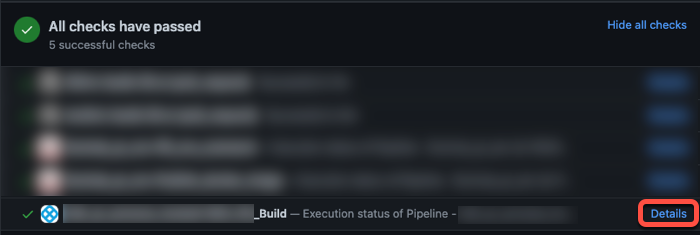SCM status checks
If your pipelines use webhook triggers, you can get Harness build statuses in your PRs. However, you must configure your protection rules in your SCM provider if you want failed/running builds to block PR merges.
Failed pipelines don't inherently block PR merges. Harness can send pipeline statuses to your PRs, but you must configure branch protections and checks (such as protection rules, CODEOWNERS, linting, and other checks or restrictions) in your source control provider.
If you want to pull PR status check information into a Harness pipeline, such as to determine whether to run a specific step based on the outcome of a check, you can add custom SCM status checks to your CI pipelines.
SCM links in build details
When viewing builds in Harness, builds triggered by webhooks can include a link to the PR or commit that started the build.
![]()
Pipeline links in PRs
When viewing a PR in your SCM provider, if a manual or webhook build ran from that PR, then you can follow the Details link from the PR's Git status to the build details page in Harness. This is supported for both manual and webhook PR builds, but it is not supported for all SCM providers.

To get status updates in your PRs, you must:
- Configure a default codebase for your pipeline. Your pipeline must have a Build stage. Build updates are only exported for Build stages.
- Make sure you enable API access in your code repo connector settings.
- Run PR builds. Branch and tag builds don't send PR status updates. You can use webhook triggers to automatically run builds when PRs are created or updated.
Custom SCM status checks
If you want to pull PR status check information into a Harness pipeline, you can use Run steps to query your SCM provider's API and include custom SCM status checks in your CI pipelines.
Add a custom status check
These steps explain how to add a status check that uses the GitHub API. For information about leveraging another SCM provider's API, refer to that provider's API documentation.
-
You need a CI pipeline with a Build stage where you'll add the Run step.
-
Create GitHub Personal Access Token to use for authentication, and save the token as a Harness text secret.
-
Add a Run step to your Build (
CI) stage. -
Enter a Name for the step.
-
If required by your build infrastructure, provide the Container Registry and Image.
- Container Registry is a container registry connector, such as a Docker connector.
- Image is the FQN or artifact name and tag of a Docker image that has cURL installed, such as
curlimages/curl:latestfor the official cURL Docker Hub image. - To learn more about this setting and when it is required, go to Use Run steps - Container Registry and Image.
-
For Shell, select Sh.
-
In Command, enter a script that calls the GitHub API, for example:
curl -i -X POST \
-H "Authorization: Bearer <+secrets.getValue('account.YOUR_GITHUB_TOKEN_SECRET_ID')>" \
-H "Accept: application/vnd.github.v3+json" \
https://api.github.com/repos/YOUR_GITHUB_ORGANIZATION/<+pipeline.properties.ci.codebase.repoName>/statuses/<+codebase.commitSha> \
-d '{"state":"pending","target_url":"<+pipeline.execution.url>","description":"Test is running","context":"harness-ci/tests"}'The above example calls the GitHub API and uses the GitHub token secret for authentication. It uses expressions to pull information from the pipeline, such as the target repository name (
<+pipeline.properties.ci.codebase.repoName>) and the pipeline build link (<+pipeline.execution.url>).If you use the above script, replace
YOUR_GITHUB_ORGANIZATIONwith your GitHub organization name, and replaceYOUR_GITHUB_TOKEN_SECRET_IDwith the ID of the Harness text secret that contains your GitHub personal access token. -
Configure additional settings as necessary for your script and build infrastructure. For example, you might want to set container resource limits, export output variables, or inject environment variables. For more information about Run step settings, go to Use Run steps.
The above script is a basic GitHub status check. You can modify the script to include more commands, get other information from the payload, or call a different SCM provider's API. For example, the following script takes different actions depending on the resulting status, and it includes environment variables and conditional execution settings:
# status="<+execution.steps.STEP_ID.status>"
# name="harness-ci/tests"
echo "Send Commit Status"
if [[ "$status" == "SUCCEEDED" ]]; then
state="success"
description="$name scan passed for <+pipeline.properties.ci.codebase.repoName>"
elif [[ "$status" == "PENDING" ]]; then
state="pending"
description="$name scan pending for <+pipeline.properties.ci.codebase.repoName>"
else
state="failure"
description="$name scan failed for <+pipeline.properties.ci.codebase.repoName>"
fi
curl -i -u YOUR_GITHUB_ORGANIZATION:<+secrets.getValue("account.YOUR_GITHUB_TOKEN_SECRET_ID")> \
-X POST \
-H "Accept: application/vnd.github.v3+json" \
https://api.github.com/repos/YOUR_GITHUB_ORGANIZATION/<+pipeline.properties.ci.codebase.repoName>/statuses/<+codebase.commitSha> \
-d "{\"state\":\"$state\",\"target_url\":\"<+pipeline.execution.url>\",\"description\":\"$description\",\"context\":\"$name\"}"
Create reusable status check steps
If you want to include status checks in multiple pipelines, you might want to create reusable templates or plugins.
- Create a step template
- Write a custom plugin
Step templates help you quickly reuse customized or complex steps in multiple pipelines. For example, here is a YAML example of a step template for a GitHub status check step:
template:
name: Send GitHub Status
type: Step
projectIdentifier: YOUR_HARNESS_PROJECT_ID
orgIdentifier: YOUR_HARNESS_ORGANIZATION_ID
spec:
type: Run
spec:
connectorRef: account.harnessImage
image: curlimages/curl:7.82.0
shell: Sh
command: |+
# status="<+execution.steps.STEP_ID.status>"
# name="harness-ci/tests"
echo "Send Commit Status"
if [[ "$status" == "SUCCEEDED" ]]; then
state="success"
description="$name scan passed for <+pipeline.properties.ci.codebase.repoName>"
elif [[ "$status" == "PENDING" ]]; then
state="pending"
description="$name scan pending for <+pipeline.properties.ci.codebase.repoName>"
else
state="failure"
description="$name scan failed for <+pipeline.properties.ci.codebase.repoName>"
fi
curl -i -u YOUR_GITHUB_ORGANIZATION:<+secrets.getValue("account.YOUR_GITHUB_TOKEN_SECRET_ID")> \
-X POST \
-H "Accept: application/vnd.github.v3+json" \
https://api.github.com/repos/YOUR_GITHUB_ORGANIZATION/<+pipeline.properties.ci.codebase.repoName>/statuses/<+codebase.commitSha> \
-d "{\"state\":\"$state\",\"target_url\":\"<+pipeline.execution.url>\",\"description\":\"$description\",\"context\":\"$name\"}"
envVariables:
status: <+input>
name: <+input>
imagePullPolicy: IfNotPresent
when:
stageStatus: Success
condition: <+codebase.build.type>=="PR"
identifier: Send_Git_Status
versionLabel: 1.0.0
You can package your status check script in a custom plugin and then add it to your pipelines in a Plugin step.
Troubleshoot status checks
Go to the Harness CI Knowledge Base for common questions and issues related to codebases and SCM status checks, such as:
- Failed pipelines don't block PR merges.
- Pipeline status updates aren't sent to PRs.
- Build statuses don't show on my PRs, even though the code base connector's token has all repo permissions.
For troubleshooting information for Git event (webhook) triggers, go to Troubleshoot Git event triggers.